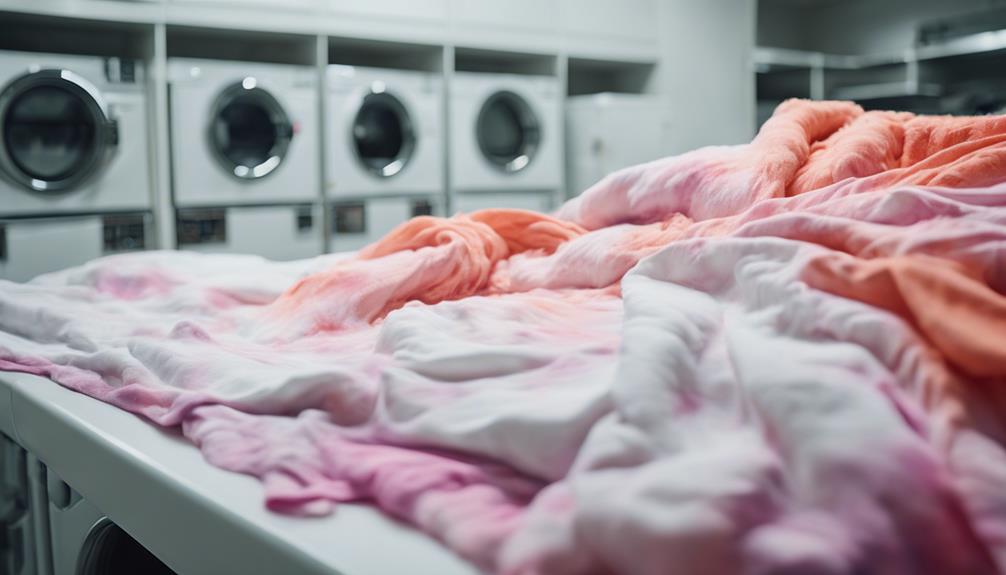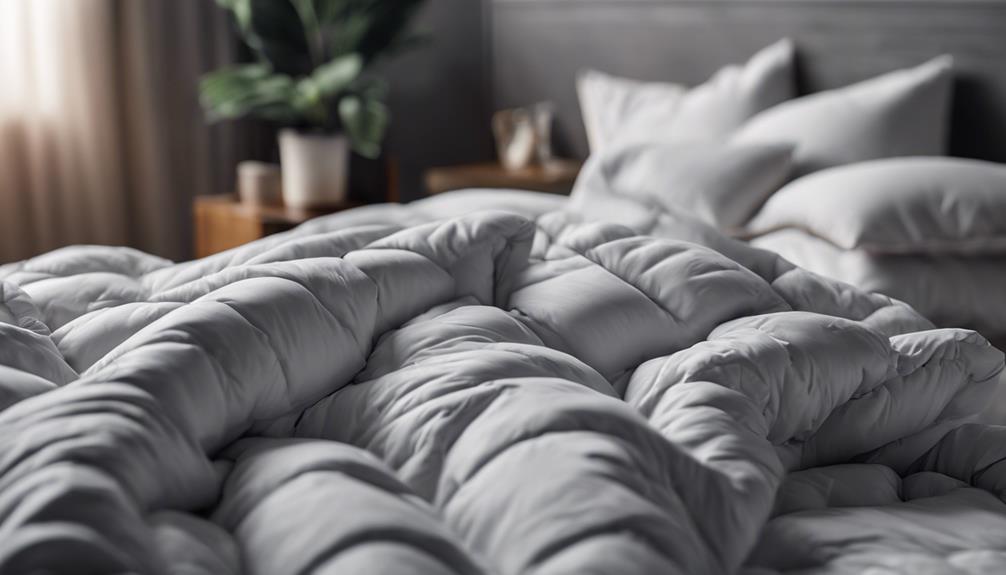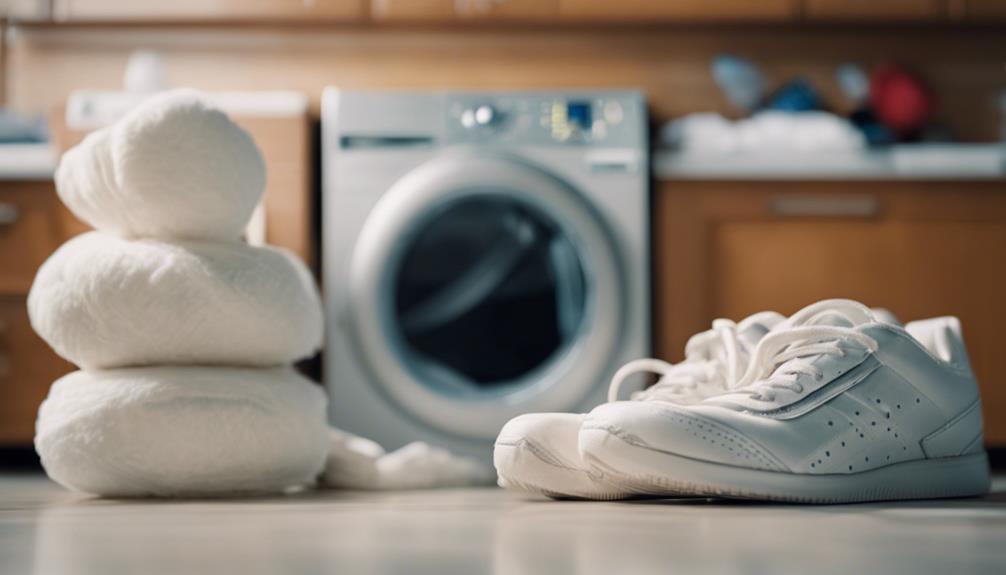Yes, you can launder your comforter at home. Begin by reviewing the care label for guidance. Eliminate any embellishments and spots before placing it in a washing machine with a large capacity. Incorporate a gentle detergent, opt for a delicate cycle, and ensure thorough drying in a large-capacity dryer. Occasionally fluff the comforter to uphold its plushness. Adhering to these steps will aid in upholding the excellence of your bedding. For more advice on extending the lifespan of your comforter, refer to the comprehensive care and maintenance instructions provided.
Key Takeaways
- Check care label for specific washing instructions.
- Use a large capacity washing machine for thorough cleaning.
- Add mild detergent and wash on a gentle cycle.
- Dry thoroughly in a large capacity dryer.
- Fluff periodically to maintain loftiness.
Preparing Your Comforter for Washing

Before throwing your comforter into the washing machine, it's vital to properly prepare it for washing. Check the care label for specific instructions on water temperature and detergent to use. Remove any duvet covers or decorative elements attached to the comforter. Inspect the comforter for stains, tears, or loose seams that may require spot cleaning or repair before washing. Give the comforter a good shake to evenly distribute the filling and prevent clumping during the wash cycle.
When preparing to wash your comforter, make sure to use a front-loading washing machine with a gentle cycle and set the water temperature to cold. This will help guarantee a thorough yet gentle clean for your comforter. Avoid using hot water or strong detergents that may damage the fabric or affect the comforter filling. After washing, follow the care label instructions for drying the comforter properly to maintain its quality and prolong its lifespan.
Selecting the Right Washing Machine

When selecting a washing machine for your comforter, it's crucial to take into account the capacity and water temperature settings. Look for a front-loading washer with a capacity of at least 5.0 cu. ft. to make sure your comforter can move freely for thorough cleaning.
Additionally, choose a machine with temperature settings suitable for the material of your comforter to achieve best results.
Washing Machine Capacity
Selecting the right washing machine for washing a comforter at home involves considering a machine with at least 5.0 cu. ft. capacity to guarantee effective cleaning. It's important to make sure the comforter has enough room to move freely within the machine for best washing results.
For oversized comforters that may not fit well in a standard home machine, utilizing a commercial washer at a laundromat could be a practical solution. In cases where professional cleaning is necessary, dropping off the comforter at a dry cleaner is recommended.
Cleaning comforters 2-4 times a year is generally sufficient, but additional washings may be needed for heavily soiled bedding or seasonal items that are used intermittently throughout the year.
Water Temperature Settings
Considering the various comforter materials and their specific cleaning requirements, we recommend choosing a washing machine with adjustable water temperature settings.
When washing cotton or synthetic comforters, opt for the warm water setting to effectively eliminate dirt and stains. For delicate comforters like silk or wool, it's best to use the cold water setting to prevent any damage during the washing process.
Always refer to the care label instructions on the comforter to determine the appropriate water temperature for washing. Adjust the water temperature based on the fabric type and cleaning requirements of the comforter to guarantee proper care.
Choosing the Appropriate Detergent
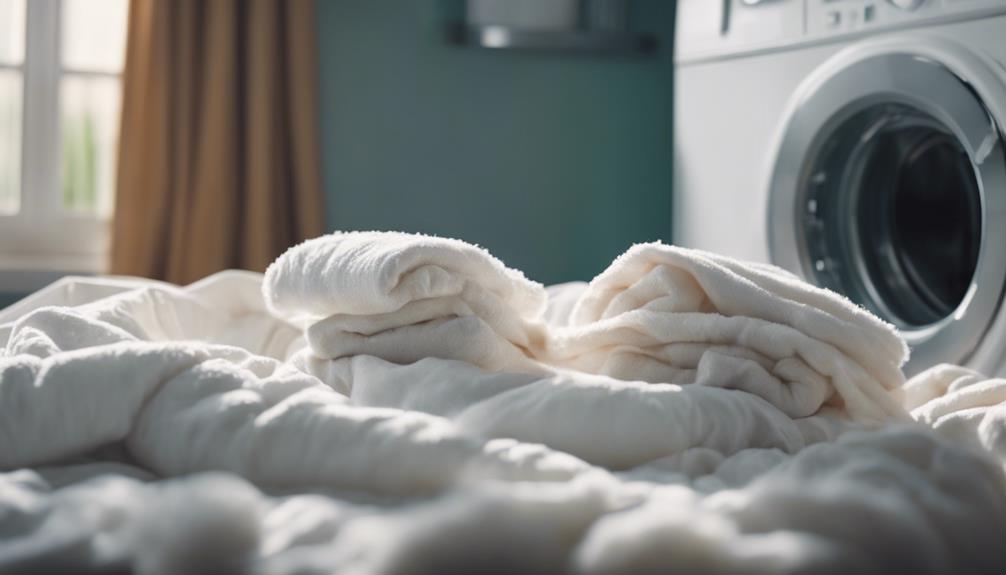
For optimal results when washing a comforter at home, it's essential to choose a gentle, low-sudsing detergent that's suitable for the specific fabric of the comforter. Selecting the right detergent plays a vital role in maintaining the quality and longevity of your comforter during the washing process.
Harsh chemicals and softeners should be avoided as they can potentially damage the comforter material. Refer to the care label on the comforter for specific recommendations on the type of detergent that best suits the fabric.
If you have sensitive skin or environmental concerns, opting for eco-friendly or hypoallergenic detergents can be beneficial. These detergents are designed to be gentle on both the fabric and your skin, ensuring a thorough yet safe cleaning process.
Washing and Drying Process
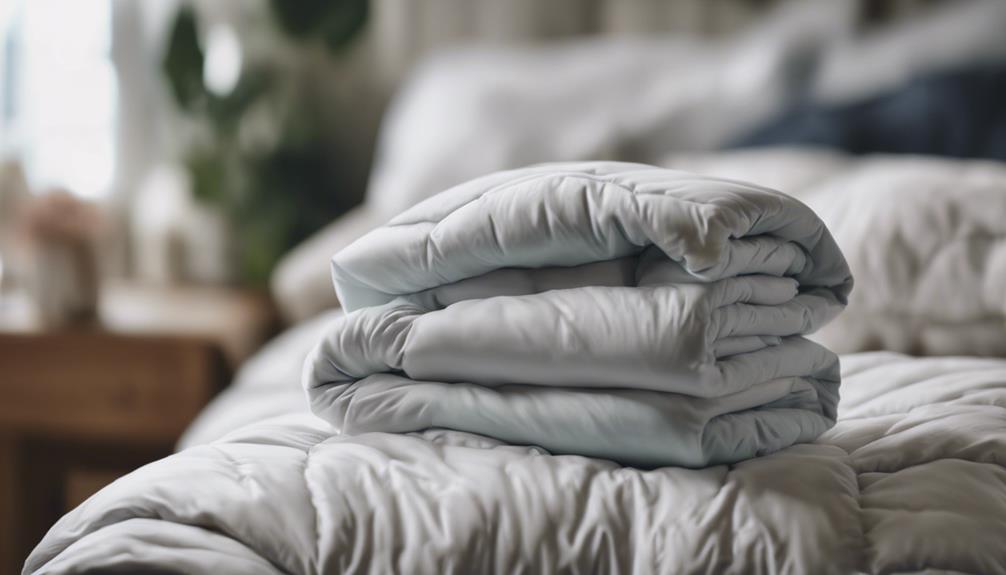
Now, let's move on to the washing and drying process for your comforter.
We'll cover essential tips for washing your comforter with care, share some tricks for effective drying, and discuss techniques for removing stubborn stains.
Wash Comforter Care
When washing a comforter at home, it is important to choose a large capacity washer with a gentle cycle to guarantee proper cleaning and maintenance. Before loading the comforter, spot clean any stains and repair damages following the care label instructions for water temperature, detergent selection, and cycle settings. To maintain the comforter's fluffiness, remember to redistribute the filling during the drying process. It is essential to make sure the comforter is completely dry before use or storage to prevent mildew and odors.
| Washing Tips | Care Instructions |
|---|---|
| Choose large capacity washer | Follow care label for settings |
| Spot clean stains and repair | Use recommended detergent |
| Fluff and redistribute filling | Ensure comforter is completely dry |
| Gentle cycle for cleaning | Prevent mildew and odors |
Drying Tips and Tricks
To enhance the fluffiness and maintain the quality of your comforter during the drying process, consider incorporating wool dryer balls for effective redistribution of the filling. Guarantee the comforter is completely dry before use or storage to prevent mildew and odors.
If a large capacity dryer isn't available, consider air drying the comforter for even drying. Customize the drying cycle by using low heat settings to protect the comforter's material.
Throughout the drying process, remember to fluff and shake the comforter every half hour to maintain loft and ensure even drying. These tips and tricks will help protect your comforter and safeguard it stays in top condition for a cozy night's sleep.
Stain Removal Techniques
During the washing and drying process of your comforter, employing effective stain removal techniques is crucial for maintaining its cleanliness and quality. To tackle stains effectively, pre-treat them before washing to make sure they're lifted during cleaning.
Use warm water during the rinse cycle to help break down dirt and residue. Opt for a delicate cycle and gentle detergent to avoid damaging the comforter. After washing, run an extra rinse cycle without soap to eliminate any detergent residue.
For tough or set-in stains that are hard to remove at home, consider professional cleaning. By following these stain removal techniques, you can keep your comforter looking fresh and spotless.
Maintenance Tips for Longevity
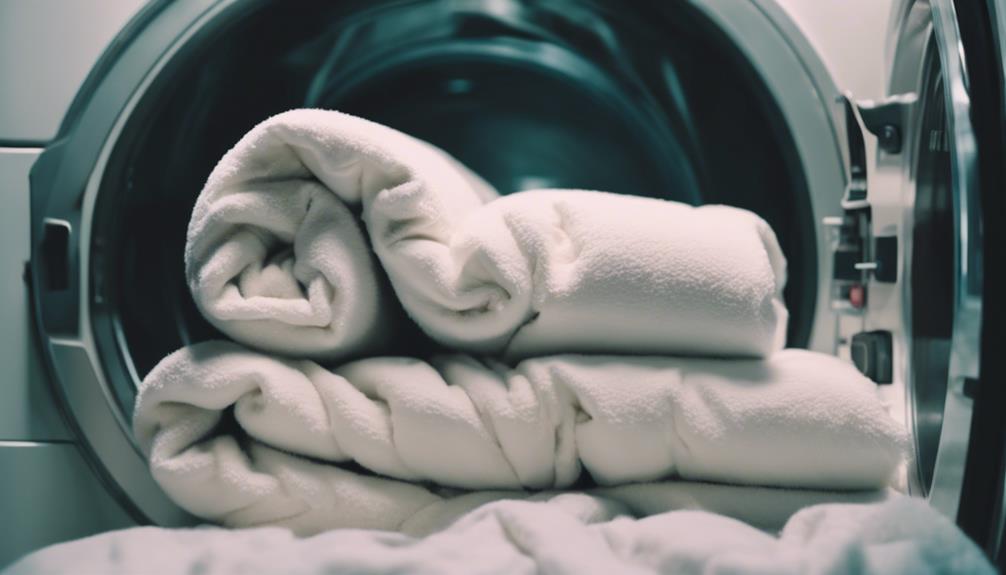
Regularly cleaning your comforter every few years can greatly prolong its lifespan. To maintain your comforter's longevity, it's crucial to follow proper care and maintenance tips.
Running the comforter through the dryer every 3-4 weeks can help eliminate dust mites that may accumulate over time. When using the dryer, opt for low heat settings to prevent any damage to the comforter's fabric or filling.
For a deeper clean, consider washing the comforter in a large capacity washing machine. Deep cleaning by a professional expert can also help revive a flat comforter after several years of use, restoring its fluffiness and comfort.
Professional Care Alternatives
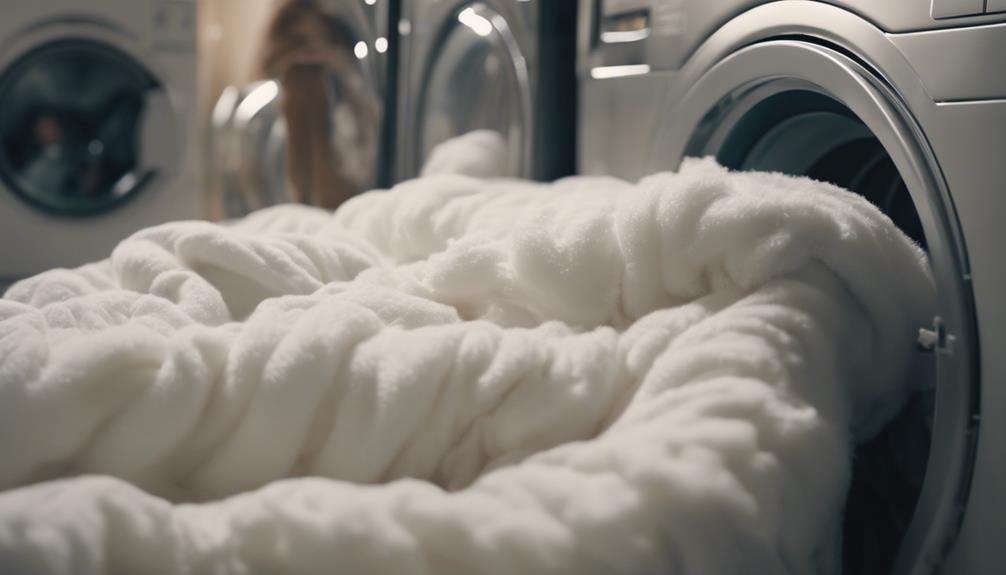
Considering the delicate nature or size of your comforter, seeking professional care at a dry cleaner could be a beneficial alternative for thorough cleaning and maintenance. When opting for professional care, keep in mind the following:
- Handling Delicate Comforters: Dry cleaners are equipped to handle delicate fabrics and intricate designs that may require special care.
- Cleaning Oversized Comforters: Large or oversized comforters can be challenging to wash at home, making professional cleaning a convenient option.
- Using Specialized Detergents: Dry cleaners use specialized detergents and techniques to guarantee a deep clean without damaging the fabric.
- Extending Lifespan and Maintenance: Professional cleaning not only removes stains effectively but also aids in maintaining the quality of the comforter, revitalizing it, and ultimately extending its lifespan.
Frequently Asked Questions
Can You Wash a Comforter in a Regular Washing Machine?
Yes, you can wash a comforter in a regular washing machine as long as it has a capacity of at least 5.0 cu. ft. Make sure the comforter has enough room to move freely for effective cleaning. If you have an oversized comforter, consider using a commercial washer at a laundromat.
Always check the care tag for specific washing instructions based on the material. Clean comforters 2-4 times per year, with more frequent washing for soiled or seasonal bedding.
Should You Wash a Comforter by Itself?
When washing a comforter, it's recommended to do so separately to guarantee proper cleaning and prevent potential damage. This allows the comforter to have the necessary space to move freely in the washer for effective cleaning.
Mixing it with other laundry items may lead to tangling and uneven cleaning, risking harm to the fabric or filling.
Following care label instructions for washing the comforter alone is essential for maintaining its quality and longevity.
Is It Better to Wash or Dry Clean a Comforter?
Dry cleaning a comforter can help maintain its shape and quality, especially for delicate or oversized comforters. Some comforters may have specific dry cleaning requirements that are best followed to avoid damage. Professional dry cleaning guarantees thorough dirt removal and can extend the lifespan of the comforter.
It's recommended for tough stains that may not be effectively removed through regular washing. Storing a clean comforter in a breathable bag after dry cleaning helps preserve its freshness and quality.
How to Clean a Comforter Too Big for a Washer?
When dealing with a comforter too big for a washer, consider using a commercial washer at a laundromat as a solution. It's important to check the care tag for specific washing instructions based on the comforter's material and size.
Before washing, spot clean stains and repair any tears. Opt for a front-loading washing machine for larger items like oversized comforters. If home washing isn't feasible, professional cleaning options such as dry cleaning can provide a thorough solution.
Is it Safe to Wash Comforter at Home if I Have a Washing Machine With an Agitator?
Yes, it is safe to consider washing comforter in agitator machine. However, be sure to follow the manufacturer’s instructions for your comforter and machine to prevent any potential damage. Using a gentle cycle and mild detergent can help keep your comforter clean without causing any harm.
Conclusion
To sum up, washing your comforter at home is a straightforward and cost-effective way to keep it clean and fresh. By following the proper steps outlined in this article, you can maintain the quality and longevity of your bedding.
Remember, a stitch in time saves nine – taking care of your comforter now will prevent future issues and guarantee a cozy night's sleep for years to come.
Enjoy your freshly washed comforter!

